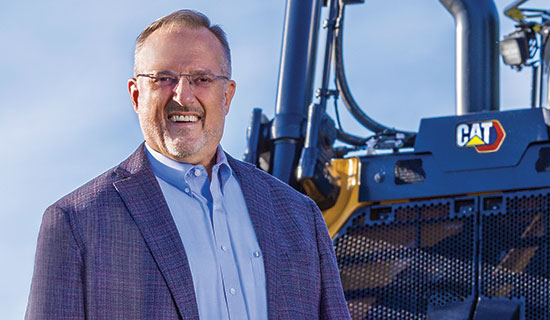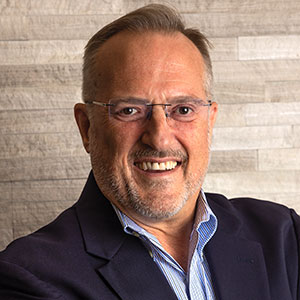When Ken Taylor joined his family’s business, Ohio Machinery Co., in January 1988, he knew he had a lot to learn about running a Caterpillar equipment dealership — even though he had grown up around the business, standing in awe of the huge coal mining machines he saw at trade shows as a kid. ϒ After earning an economics degree and working as a research assistant at the Federal Reserve in Washington, D.C., for three years, he came back to the family business eager to gain some tangible knowledge of the company and its products and people. ϒ “To start out,” Taylor says, “I really felt the importance of working from the ground up.” ϒ As an authorized dealer for Cat®, Ohio Machinery Co. provides new and used equipment, along with parts, service and support, for markets ranging from mining and natural gas to construction, landscaping and agriculture. He started out working in the parts warehouse in Youngstown, then moved through the company’s four other locations and into the field as he spent time in service, finance, sales and other departments. ϒ “I really learned the nuts and bolts of the equipment business,” he says, “and I was able to work with just about everybody in the company, which was about 400 employees at that time.”
In 1994, six years into his tenure, tragedy interrupted Taylor’s steady career progression when his father, Tom Taylor Jr., only 59 at the time, died from chronic hepatitis B.
“That left me taking on the role of president at the age of 32, certainly ahead of schedule,” he says.
Although he’d taken “calculated steps” to gain exposure to the business by pursuing a progression of roles while earning his MBA from the Weatherhead School of Management at Case Western Reserve University, the sudden transition caught everyone off-guard. To navigate the abrupt succession, he leaned on the team that his father had carefully built.
“In that kind of crisis, it’s critical to have a good team in place,” Taylor says. “Fortunately, I had terrific managers that my dad had selected over time. With their leadership and support, and guidance from Caterpillar along the way, we were able to continue moving forward.”
Here’s how Taylor continues building and training a strong team to secure future generations of growth for the family business.
History of growth
Founded in 1945, Ohio Machinery Co. started out selling Caterpillar equipment throughout 66 of Ohio’s 88 counties. Taylor’’s grandfather, Tom Taylor Sr., covered seven Northeast Ohio counties in his sales territory.
“He was iconic in his sales personality and abilities,” Taylor recalls.
Ken Taylor’s father, Tom Taylor Jr., joined the company in 1959 with an MBA from Wharton School of Business. In 1961, when the founding partners of Ohio Machinery Co. retired and Caterpillar reorganized its sales territories, Ken’s father and grandfather acquired ownership of Eastern Ohio, which spanned 25 counties predominantly serving the heavy construction, manufacturing and mining industries.
The next growth spurt didn’t come until April 2003, when Ohio Machinery Co. acquired Caterpillar’s Western Ohio region and began doing business as Ohio CAT, Ohio’s sole distributor of Caterpillar products.
“We were able to double the company in employment and volume, and more than double its geography,” Ken says. “In a way, we returned to our roots of covering the whole state.”
The expansion diversified the company by tapping into Caterpillar’s broad product line to serve other markets across the state — from oil and gas to marine and power generation. Ken’s daughter, Gillian, was still in school at the time, but she remembers the milestone clearly.
“Our family hosted a dinner at our house for some of the company leadership when we acquired the western half of Ohio,” Gillian says. “I’ll never forget that dinner because it started my dad’s passion for all things Ohio. He loves that our business can support so many other industries, and having this well-rounded portfolio of different divisions really contributes to our whole state.”
Ohio Machinery Co. diversified again by acquiring two Peterbilt diesel truck dealerships in 2018 and 2019, rebranding this business as Ohio Peterbilt, which spans 11 locations today. These two main brands — Caterpillar and Peterbilt — comprise the bulk of Ohio Machinery Co.’s sales, which reached approximately $1.5 billion last year.
Expanding the talent pool
With nearly 1,800 employees across 41 locations today, Ohio Machinery Co. faces a constant challenge of finding the workforce to support its ongoing growth.
“We have to go to extraordinary lengths to find people,” Ken says. “That’s where we were really challenged, especially when hiring service technicians.”
As tightening labor shortages shrank the pool of skilled technicians, the Taylors shifted their focus from finding talented candidates to creating them instead. To that end, the company rolled out several programs aimed at developing its workforce — like internships that provide “a three-month bootcamp-type of training” to bring entry-level workers up to speed in the service department, and programs that combine a two-year associate’s degree with additional training on engine repair and maintenance.
As part of the company’s commitment to developing employees, Ohio Machinery Co. hired a new manager of talent acquisition and development last year.
“We’ve always had internal technical training when it comes to our products, and we certainly get great support from Caterpillar and Peterbilt,” Ken says. “Now, we’ve got the leadership to grow our internal training resources,” which now include non-technical skills such as leadership development and performance management.
Training, however, is only half of the challenge when onboarding new hires. The other piece is constant communication to keep employees aligned with the company vision. For most of his tenure as president, Ken handled internal communications — even launching KTTV (Ken Taylor TV) in 2011. But, he says, “we got so big so quickly that it was outpacing me.”
So, in August of 2020, Ken’s daughter, Gillian Taylor Henning, stepped in as the company’s first corporate communications specialist. She spearheaded content development for the company’s intranet and other channels, producing monthly video segments from the KTTV studio in addition to regular safety training videos and highlights of employee and customer success stories. Thanks to her efforts, Ken says, “We’re telling those stories internally, instead of just assuming everyone knows.”
Nurturing the next generation
Following several decades of minimal changes in the executive suite, Ohio Manufacturing Co. recently experienced a “turnover in top leadership,” as all of the original managers that Ken inherited and selected back in the early 1990s have now retired.
This changeover is creating a lot of opportunities for upward mobility, as “the next middle management bench has begun to step up,” Ken says. “That’s really what we prefer to do, is promote from within the people who love our business and have proven to be successful.”
After leaning on his management team to survive his abrupt leadership transition, Ken realized the importance of developing future leaders throughout the company.
“It’s about gaining deep experience in the business, supplemented by training and development,” Ken says. “Then, as opportunities open up, we have people available.”
Looking ahead at the future of the family business, a formal succession plan was critical to prepare the next generation for leadership. In 2019, the Taylors began meeting with a family business consulting firm, Banyan Global, to put a succession plan in place. They meet four times a year to talk through their expectations, values and strategic long-term vision for passing the torch.
“It’s a very organized, methodical approach,” designed to bring the fourth generation into the business through a rotation of increasing responsibilities over the span of a decade. His daughter, Gillian, is already three years into the process. After starting as a corporate communications specialist, she completed several rotations in the parts and service department before moving into the rental department while earning her MBA.
“Something my dad taught us from the very beginning is to take every opportunity that you can,” says Gillian, 30. “With continued consultation and mentorship through these rotations, I hope to keep learning and absorbing as much information as I can to carry our family values into future generations. There’s a lot to be proud of in the legacy that my dad and his dad and grandfather laid out, and I’m excited to continue that into the fourth generation.”
Ken’s son, Gordon, also joined the company in 2023 as a Six Sigma process coordinator working on improvement projects like software implementation and process documentation. Already, this role “has allowed me to work with every department and division across the entire company,” says Gordon, 28, “which has given me great exposure to wrap my arms around everything that we do.”
Ken, 62, plans to retire at age 70, which gives the fourth generation several more years to build their experience.
“It’s important in a family business to ensure that your kids have gained enough familiarity with the business, but not too much,” he says. “They need enough exposure to know whether it’s an option, and we did that by ensuring that our kids each had at least one summer internship at the company. But you also have to respect that individuals have different dreams and passions, so being accepting of different choices is important.”
Not all of the fourth Taylor generation ended up in the family business. Ken’s oldest son, Ian, 31, pursued a career as a high school math teacher and soccer coach in Chicago. And his youngest son, Stuart, 26, works for a marketing analytics firm.
“Our parents were in full support of us following our passions and choosing a direction for our careers,” says Gillian, who pursued a career in music education before joining Ohio Machinery Co., while Gordon earned a biology degree and worked as an event coordinator before he came aboard. “They encouraged us to obtain experience outside the company to get a good perspective.”
Giving back to the community
As Ohio Machinery Co. approaches 80 years in business, the “magic” behind its enduring legacy comes down to the perfect combination of “a great product from a great company,” with the personal touch of a locally owned and operated family business. While product support and customer service are paramount to the company’s growth, the end goal isn’t just making sales but, more important, making a positive impact.
To that end, the Taylor family business is deeply rooted in philanthropy and community service. “We’re very engaged and involved in the communities where we live and work,” Ken says.
The company’s history of philanthropy goes back generations, as Ken’s parents and grandparents volunteered their time and talents to the local community. That tradition of giving still runs strong through the company, which sponsors various causes and supports the volunteer efforts of employees across the state.
The company supports local organizations that set Ohio apart — places like the Rock and Roll Hall of Fame, the Pro Football Hall of Fame, the National Museum of the U.S. Air Force in Dayton, and iconic institutions like the Cleveland Orchestra, Cleveland Metroparks and local sports teams.
By giving back, Ohio Machinery Co. continues building up the state, from major construction projects to causes behind the scenes.
“We have a history of giving back to the community, and we’ll continue that generosity through the fourth generation and into the next,” Gordon says. “Being involved in this legacy is the greatest honor. To be a part of something that has benefited Ohio’s economy tremendously is extremely exciting, and we can’t wait to see what the fourth generation will bring to the table.”


